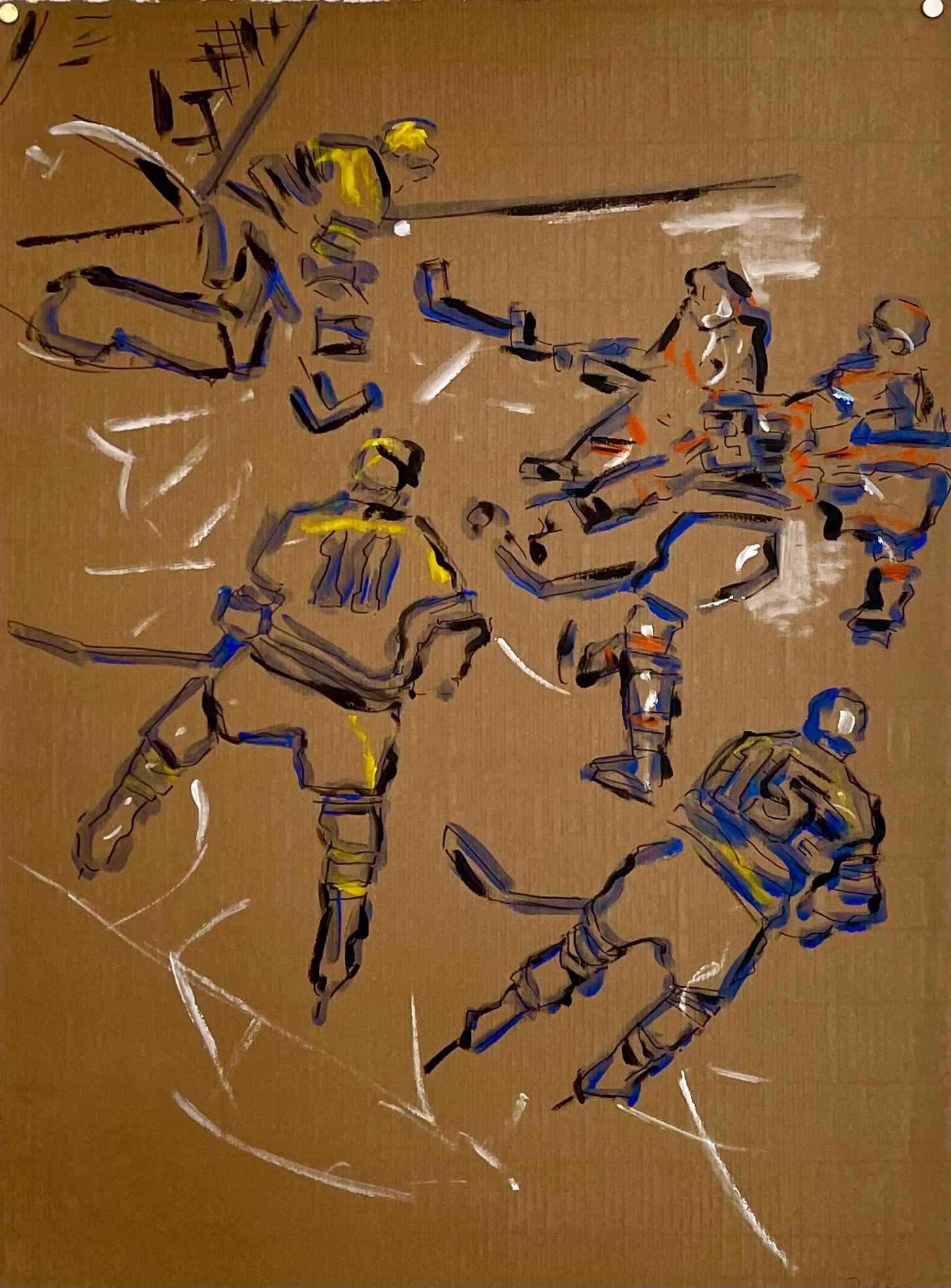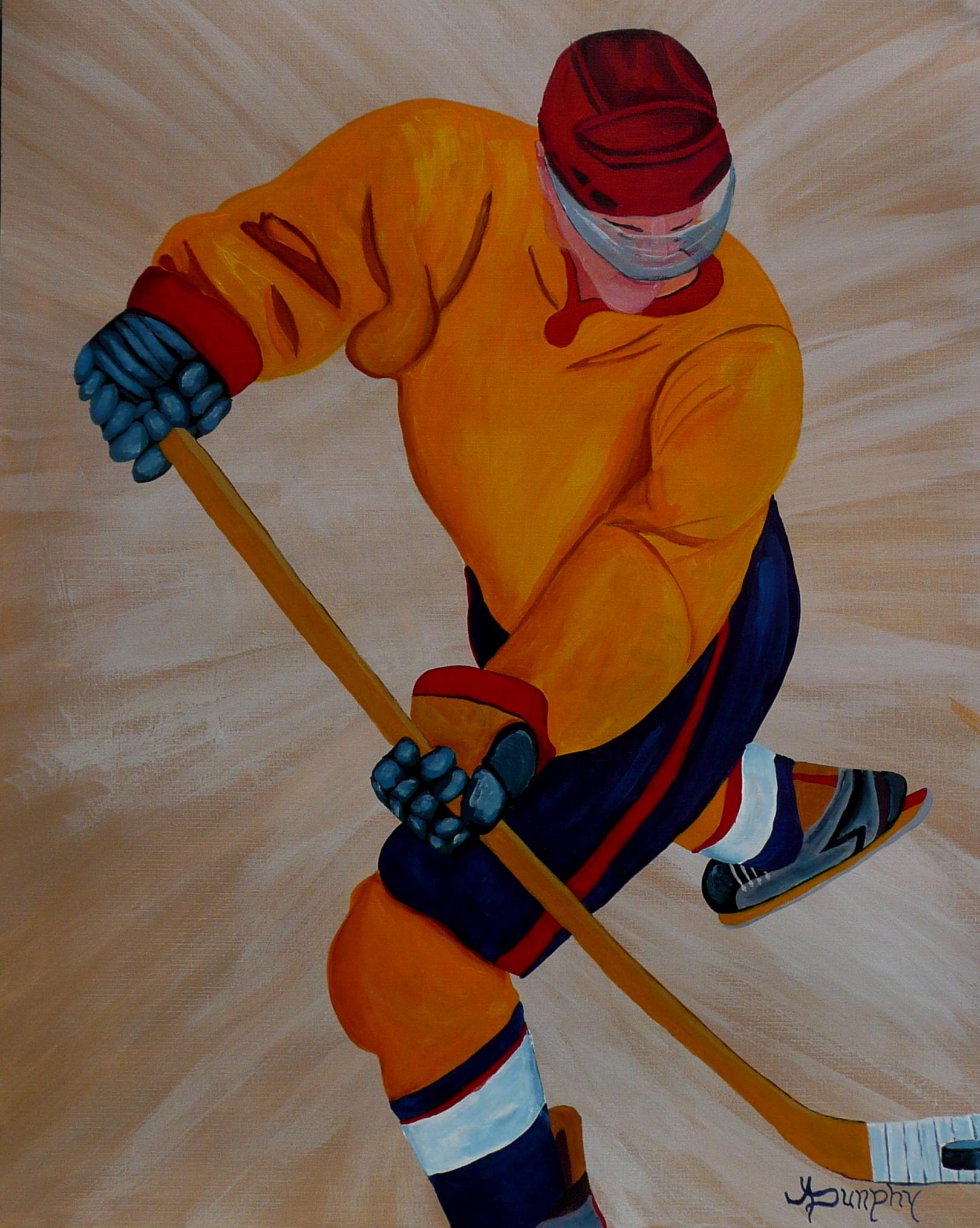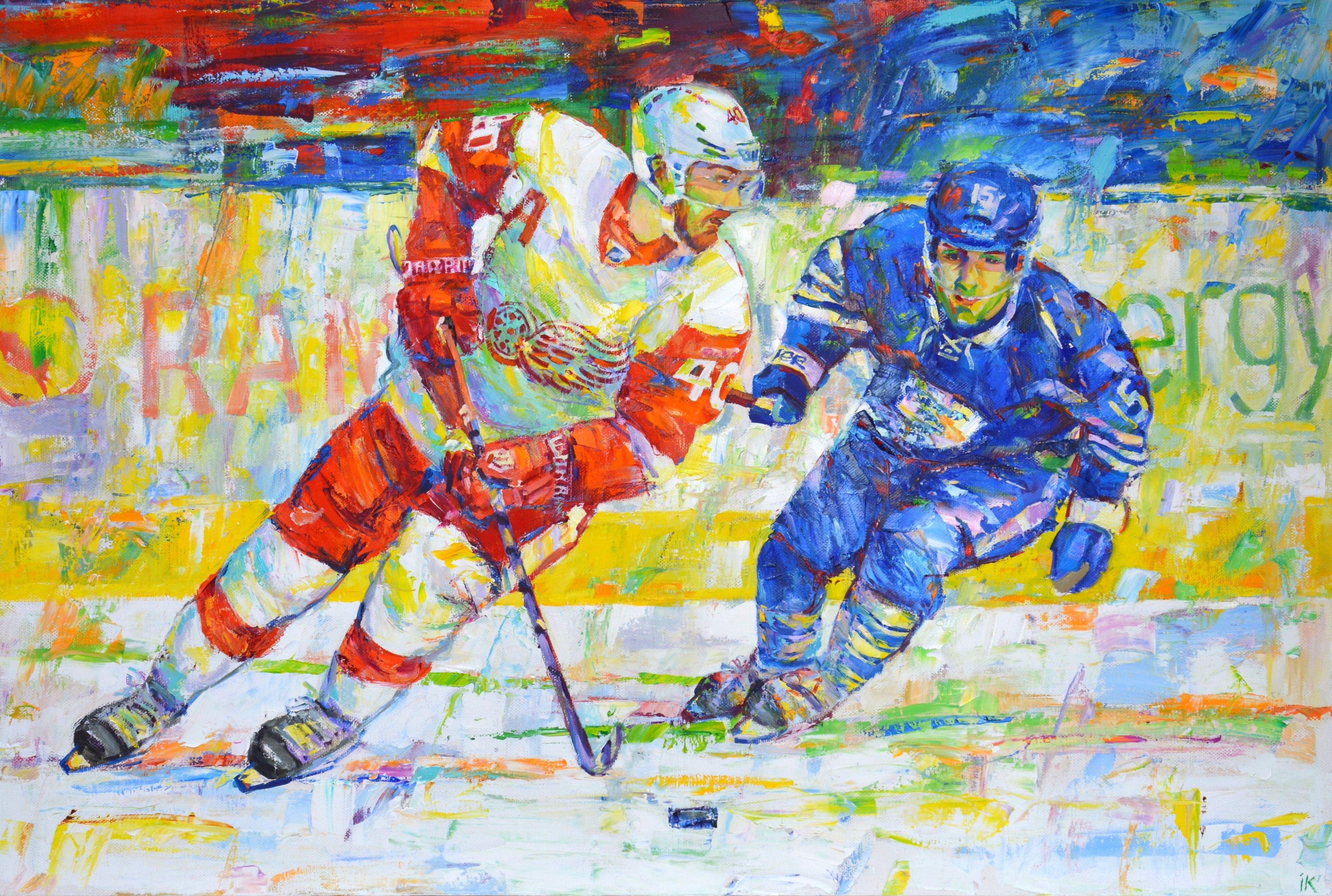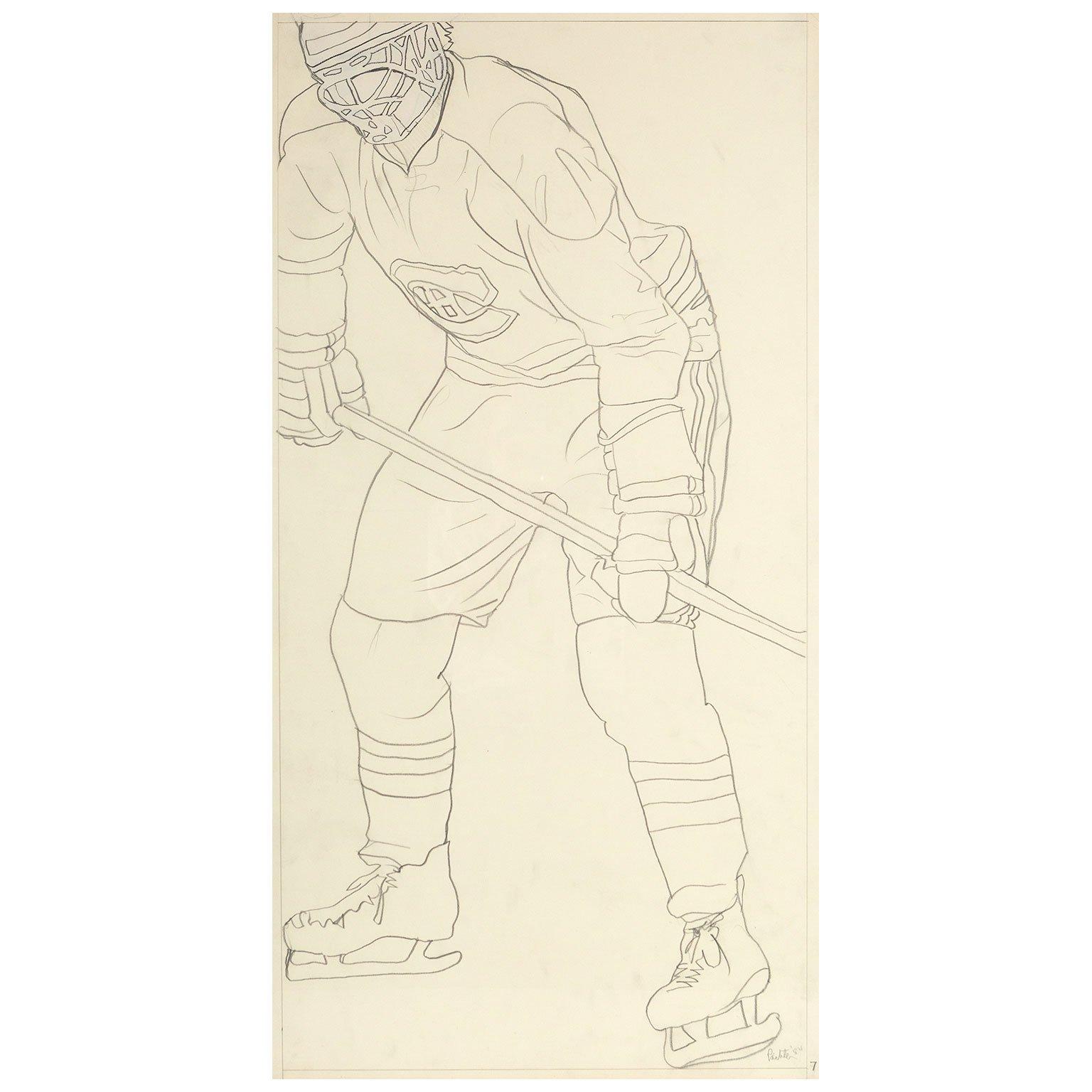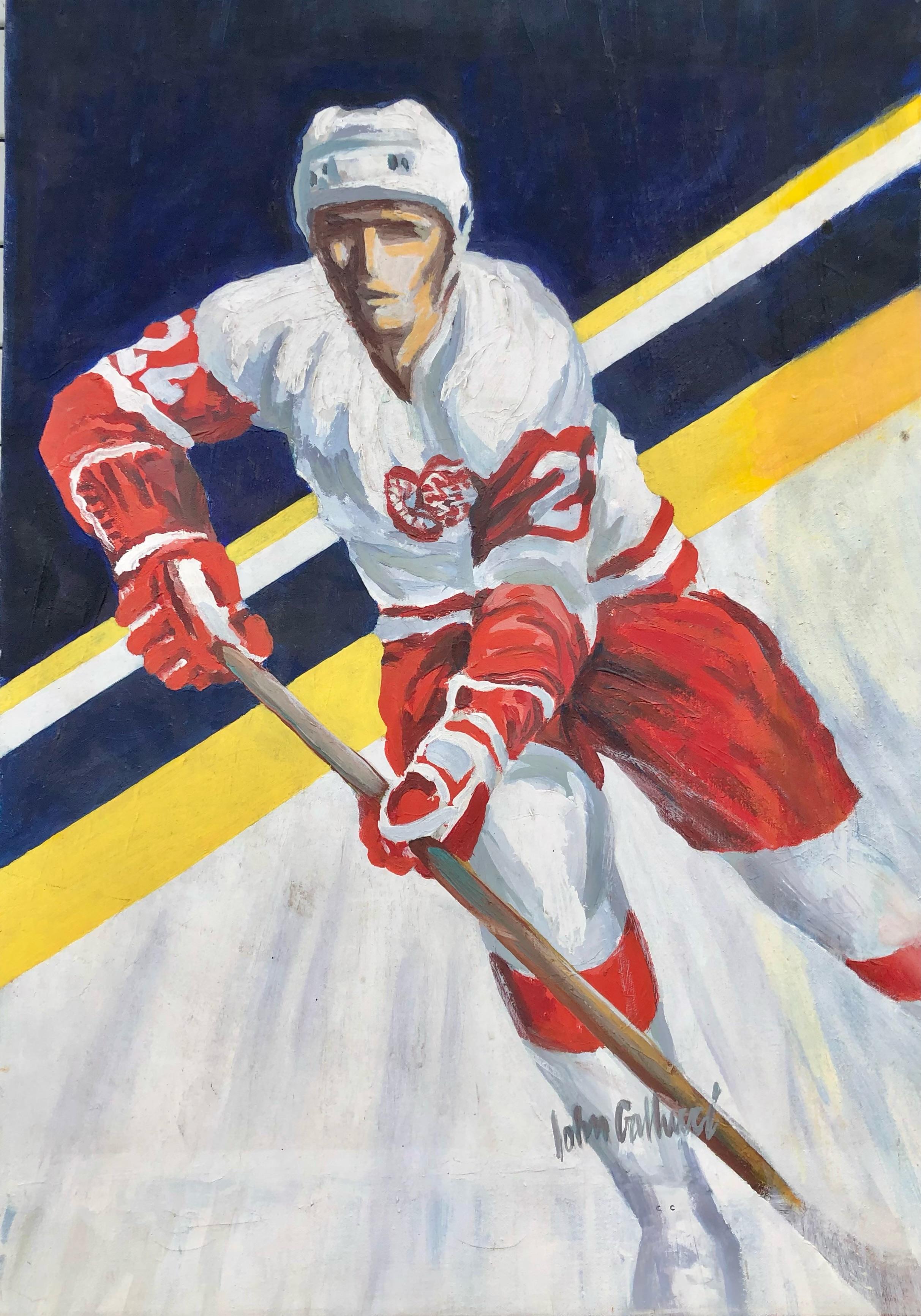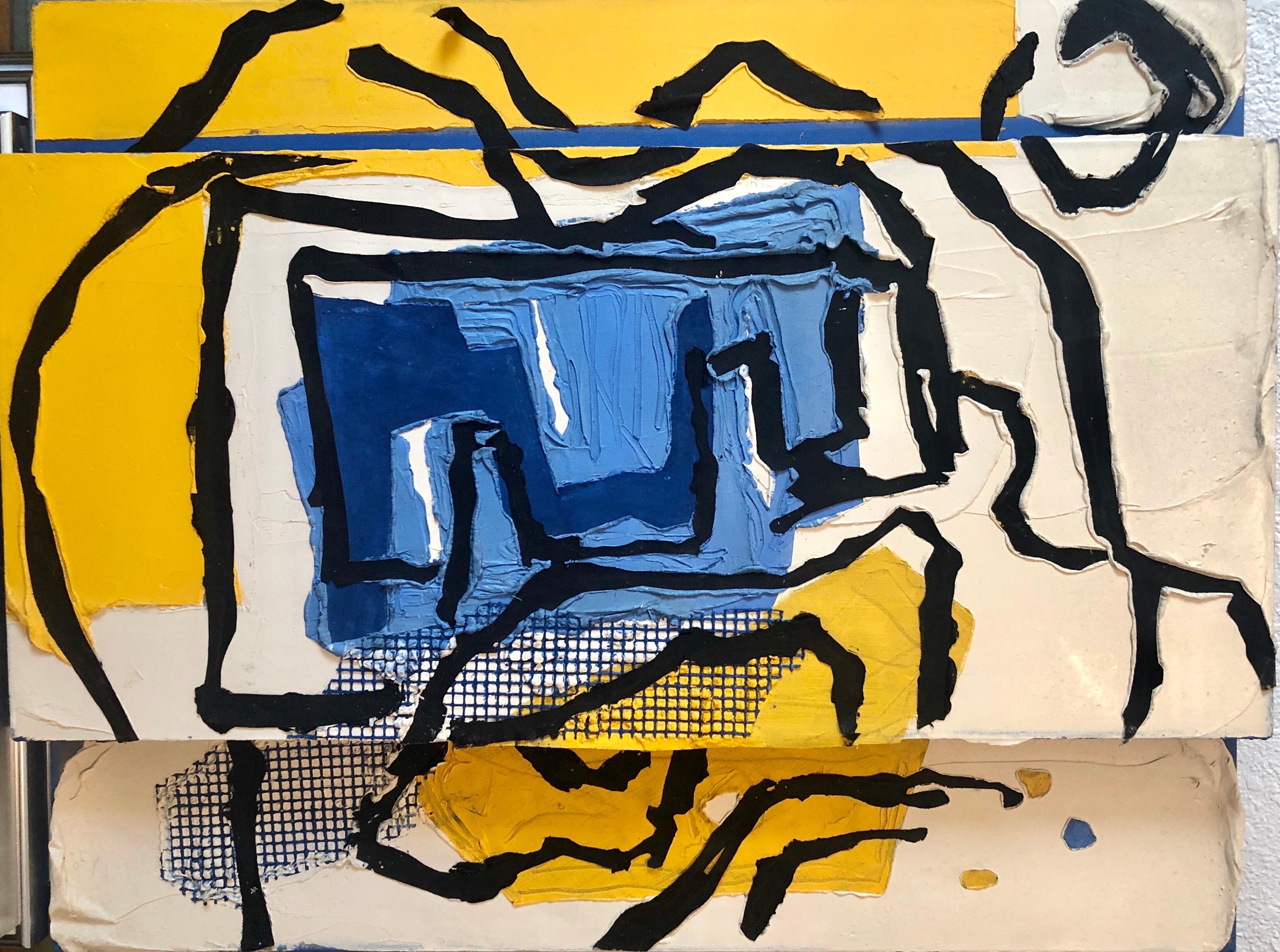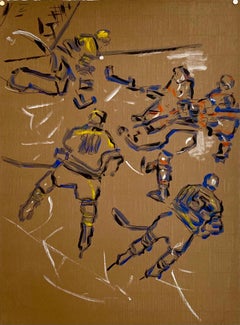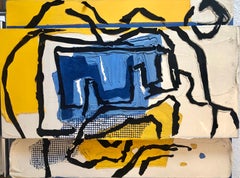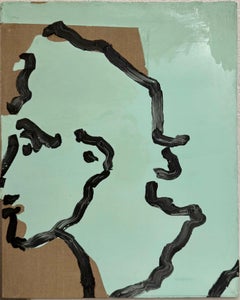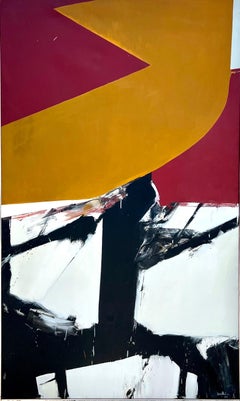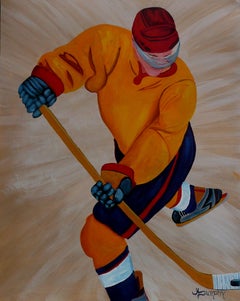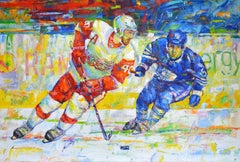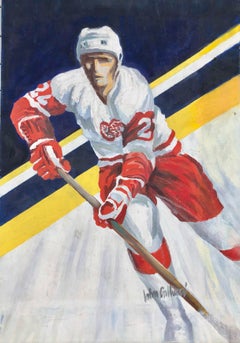Items Similar to Judy Rifka, Abstract Expressionist Oil Painting Hockey Players. Brooke Alexander
Want more images or videos?
Request additional images or videos from the seller
1 of 15
Judy RifkaJudy Rifka, Abstract Expressionist Oil Painting Hockey Players. Brooke Alexander1983
1983
$12,500
£9,438.66
€10,950.78
CA$17,566.43
A$19,571.48
CHF 10,217.24
MX$237,623.84
NOK 128,424.02
SEK 121,391.90
DKK 81,746.28
About the Item
Judy Rifka (American, b. 1945)
Oil on linen painting
Titled: "Ice Hockey IV 1990"
featuring A depiction of hockey players with ice skating rink backdrop.
Hand signed verso: "Rifka, 90"
Provenance: Brooke Alexander Gallery
DIMENSIONS: H: 44" x L: 30"
Judy Rifka (born 1945) is an American woman artist active since the 1970s as a painter and video artist. She works heavily in New York City's Tribeca and Lower East Side and has associated with movements coming out of the area in the 1970s and 1980s such as Colab and the East Village, Manhattan art scene. A video artist, book artist and abstract painter, Rifka is a multi-faceted artist who has worked in a variety of media in addition to her painting and printmaking. She was born in 1945 in New York City and studied art at Hunter College, the New York Studio School and the Skowhegan School of Painting and Sculpture in Maine.
Rifka took part in the 1980 Times Square Show, (Organized by Collaborative Projects, Inc. in 1980 at what was once a massage parlor, with now-famous participants such as Jenny Holzer, Nan Goldin, Keith Haring, Kenny Scharf, Jean-Michel Basquiat, and Kiki Smith, the roster of the exhibition reads like a who’s who of the art world), two Whitney Museum Biennials (1975, 1983), Documenta 7, Just Another Asshole (1981), curated by Carlo McCormick and received the cover of Art in America in 1984 for her series, "Architecture," which employed the three-dimensional stretchers that she adopted in exhibitions dating to 1982; in a 1985 review in the New York Times, Vivien Raynor noted Rifka's shift to large paintings of the female nude, which also employed the three-dimensional stretchers. In a 1985 episode of Miami Vice, Bianca Jagger played a character attacked in front of Rifka's three-dimensional nude still-life, "Bacchanaal", which was on display at the Museum of Art Fort Lauderdale. Rene Ricard wrote about Rifka in his influential December 1987 Art Forum article about the iconic identity of artists from Van Gogh to Jean-Michel Basquiat and Keith Haring, The Radiant Child.The untitled acrylic painting on plywood, in the collection of the Honolulu Museum of Art, demonstrates the artist's use of plywood as a substrate for painting. Artist and writer Mark Bloch called her work "imaginative surfaces that support experimental laboratories for interferences in sensuous pigment." According to artist and curator Greg de la Haba, Judy Rifka's irregular polygons on plywood "are among the most important paintings of the decade".
In 2013, Rifka's daily posts on Facebook garnered a large social media audience for her imaginative "selfies," erudite friendly comments, and widely attended solo and group exhibitions, Judy Rifka's pop art figuration is noted for its nervous line and frenetic pace. In the January 1998 issue of Art in America, Vincent Carducci echoed Masheck, “Rifka reworks the neo-classical and the pop, setting all sources in quotation for today’s art-world cognoscenti.” Rifka, along with artists like David Wojnarowicz, helped to take Pop sensibility into a milieu that incorporated politics and high art into Postmodernism; Robert Pincus-Witten stated in his 1988 essay, Corinthian Crackerjacks & Passing Go that "Rifka’s commitment to process and discovery, doctrine with Abstract Expressionist practice, is of paramount concern though there is nothing dogmatic or pious about Rifka’s use of method. Playful rapidity and delight in discovery is everywhere evident in her painting." In 2016, a large retrospective of Rifka's art was shown at the Jean-Paul Najar Foundation in Dubai. In 2017, Gregory de la Haba presented a Rifka retrospective at the Amstel Gallery in The Yard, a section of Manhattan described as "a labyrinth of small cubicles, conference rooms and small office spaces that are rented out to young entrepreneurs, professionals and hipsters". In 2019 her video Bubble Dancers New Space Ritual was selected for the International Istanbul Bienali.
Alexandra Goldman Talks To Judy Rifka About Ionic Ironic: Mythos from the '80s at CORE:Club and the Inexistence of "Feminist Art" Whitehot Magazine of Contemporary Art. She was included in "50 Contemporary Women Artists", a book comprising a refined selection of current and impactful artists. The foreword is by Elizabeth Sackler of the Brooklyn Museum’s Sackler Center for Feminist Art. Additional names in the book include sculptor and carver Barbara Segal and mixed media artist Stephanie Hirsch as well as Judy Chicago, and Teresita Fernandez, the first Latina woman to be appointed to the U.S. Commission of Fine Arts (an appointment decided by President Obama in 2011).
Select Exhibitions:
Franklin Furnace
The Museum of Modern Art, New York, MoMA
Documenta VII, Kassel
San Francisco Museum of Modern Art
Carnegie Mellon University
Institute of Contemporary Art, Philadelphia
The New Museum of Contemporary Art, New York
The Brooklyn Museum
Moderner Kunst, Vienna
Laforet Museum, Tokyo
The Hudson River Museum
Bass Museum of Art, Miami Beach
The Museum of Fine Art, Boston; Rhode Island School of Design, Providence.
Museum fur Kultur, in Berlin and Hamburg, Germany
Gracie Mansion, the residence of the Mayor in New York City
Chocolate Factory, New York City
Gallery X, New York City
Brooke Alexander, New York City
Galerie Tobias Hirshman (Frankfurt, Germany)
Ann Jaffee Gallery (Bay Harbor Islands, Florida)
Anna Friebe Galerie, Cologne
Stephen Wirtz Gallery, San Francisco, California
Galerie de France (Paris),
Printed Matter, New York City
Jean Paul Najar, Paris
John Doyle Gallery, Chicago
Select Public Collections:
Metropolitan Museum of Art, New York City
Whitney Museum of American Art,
New York Public Library
Boston Museum of Fine Arts, Massachusetts;
Staatliche Museum, Berlin, Germany.
- Creator:Judy Rifka (1945, American)
- Creation Year:1983
- Dimensions:Height: 44 in (111.76 cm)Width: 36 in (91.44 cm)Depth: 3 in (7.62 cm)
- Medium:
- Movement & Style:
- Period:
- Condition:good. minor wear commensurate with age. please see photos.
- Gallery Location:Surfside, FL
- Reference Number:1stDibs: LU38215832002
Judy Rifka
Judy Rifka (b. 1945) is an American artist active since the 1970s as a painter and video artist. She works heavily in New York City's Tribeca and Lower East Side and has associated with movements coming out of the area in the 1970s and 1980s such as Colab and the East Village, Manhattan art scene.[
About the Seller
4.9
Platinum Seller
Premium sellers with a 4.7+ rating and 24-hour response times
Established in 1995
1stDibs seller since 2014
1,798 sales on 1stDibs
Typical response time: <1 hour
- ShippingRetrieving quote...Shipping from: Surfside, FL
- Return Policy
Authenticity Guarantee
In the unlikely event there’s an issue with an item’s authenticity, contact us within 1 year for a full refund. DetailsMoney-Back Guarantee
If your item is not as described, is damaged in transit, or does not arrive, contact us within 7 days for a full refund. Details24-Hour Cancellation
You have a 24-hour grace period in which to reconsider your purchase, with no questions asked.Vetted Professional Sellers
Our world-class sellers must adhere to strict standards for service and quality, maintaining the integrity of our listings.Price-Match Guarantee
If you find that a seller listed the same item for a lower price elsewhere, we’ll match it.Trusted Global Delivery
Our best-in-class carrier network provides specialized shipping options worldwide, including custom delivery.More From This Seller
View AllJudy Rifka, Abstract Expressionist Oil Painting on Paper Hockey Players
By Judy Rifka
Located in Surfside, FL
Judy Rifka (American, b. 1945) "Ice Hockey"
Acrylic or oil paint on Fabriano paper paintings featuring multiple hockey players executed in yellow, white, purple, and black hues.
Ha...
Category
1980s Pop Art Abstract Paintings
Materials
Oil
Judy Rifka, Abstract Expressionist Oil Painting MIxed Media 3D Construction
By Judy Rifka
Located in Surfside, FL
Hand signed verso, mixed media on two sections of joined canvas
Work is titled "Ego Wall with Mess," circa 1983. Provenance: Brooke Alexander Gallery, New York, New York. bearing their label verso.
24 x 30 x 3-3/4 inches (61.0 x 76.2 x 9.5 cm) Hand signed on the reverse: Judy Rifka
Judy Rifka (born 1945) is an American woman artist active since the 1970s as a painter and video artist. She works heavily in New York City's Tribeca and Lower East Side and has associated with movements coming out of the area in the 1970s and 1980s such as Colab and the East Village, Manhattan art scene. A video artist, book artist and abstract painter, Rifka is a multi-faceted artist who has worked in a variety of media in addition to her painting and printmaking. She was born in 1945 in New York City and studied art at Hunter College, the New York Studio School and the Skowhegan School of Painting and Sculpture in Maine.
Rifka took part in the 1980 Times Square Show, (Organized by Collaborative Projects, Inc. in 1980 at what was once a massage parlor, with now-famous participants such as Jenny Holzer, Nan Goldin, Keith Haring, Kenny Scharf, Jean-Michel Basquiat, and Kiki Smith, the roster of the exhibition reads like a who’s who of the art world), two Whitney Museum Biennials (1975, 1983), Documenta 7, Just Another Asshole (1981), curated by Carlo McCormick and received the cover of Art in America in 1984 for her series, "Architecture," which employed the three-dimensional stretchers that she adopted in exhibitions dating to 1982; in a 1985 review in the New York Times, Vivien Raynor noted Rifka's shift to large paintings of the female nude, which also employed the three-dimensional stretchers. In a 1985 episode of Miami Vice, Bianca Jagger played a character attacked in front of Rifka's three-dimensional nude still-life, "Bacchanaal", which was on display at the Museum of Art Fort Lauderdale. Rene Ricard wrote about Rifka in his influential December 1987 Art Forum article about the iconic identity of artists from Van Gogh to Jean-Michel Basquiat and Keith Haring, The Radiant Child.The untitled acrylic painting on plywood, in the collection of the Honolulu Museum of Art, demonstrates the artist's use of plywood as a substrate for painting. Artist and writer Mark Bloch called her work "imaginative surfaces that support experimental laboratories for interferences in sensuous pigment." According to artist and curator Greg de la Haba, Judy Rifka's irregular polygons on plywood "are among the most important paintings of the decade".
In 2013, Rifka's daily posts on Facebook garnered a large social media audience for her imaginative "selfies," erudite friendly comments, and widely attended solo and group exhibitions, Judy Rifka's pop art figuration is noted for its nervous line and frenetic pace. In the January 1998 issue of Art in America, Vincent Carducci echoed Masheck, “Rifka reworks the neo-classical and the pop, setting all sources in quotation for today’s art-world cognoscenti.” Rifka, along with artists like David Wojnarowicz, helped to take Pop sensibility into a milieu that incorporated politics and high art into Postmodernism; Robert Pincus-Witten stated in his 1988 essay, Corinthian Crackerjacks & Passing Go that "Rifka’s commitment to process and discovery, doctrine with Abstract Expressionist practice, is of paramount concern though there is nothing dogmatic or pious about Rifka’s use of method. Playful rapidity and delight in discovery is everywhere evident in her painting." In 2016, a large retrospective of Rifka's art was shown at the Jean-Paul Najar Foundation in Dubai. In 2017, Gregory de la Haba presented a Rifka retrospective at the Amstel Gallery...
Category
1980s Pop Art Abstract Paintings
Materials
Linen, Oil
Judy Rifka Abstract Expressionist Pop Art Portrait Oil Painting Brooke Alexander
By Judy Rifka
Located in Surfside, FL
Judy Rifka (American, b. 1945)
Roman Nose
1982
Oil on canvas
Dimensions: 30 x 24 inches (76.2 x 61.0 cm) Hand signed on stretcher: Judy Rifka
Provenance: Brooke Alexander Galle...
Category
1980s Pop Art Figurative Paintings
Materials
Oil, Canvas
Large Budd Hopkins Modernist Hard Edged Abstract Expressionist Oil Painting 1965
Located in Surfside, FL
Budd Hopkins, American (1931-2011)
Strike Red
Oil on canvas, 1965, signed 'Hopkins' and dated lower right.
Dimensions: 85 x81 in., 86 x 52 in. with frame.
Provenance: bears partial label remnant verso from Poindexter Gallery. (a major gallery founded in 1955 in New York City by Elinor Poindexter. The gallery specialized in sculpture, abstract, and figurative art and featured the works of such artists as Richard Diebenkorn, Jules Olitski, Nell Blaine, Al Held, Willem de Kooning, Franz Kline, Earl Kerkam, Milton Resnick and Robert De Niro, among others.
Budd Hopkins was one of the leading proponents of the "hard-edge" abstract minimalist school of painting in the 1950s and 1960s, Budd Hopkins (born 1931) created works that show the strong influence of Jackson Pollock and other leading painters of the Abstract Expressionism movement. Hopkins' paintings are now in numerous major collections, including the San Francisco Museum of Art, the Guggenheim Museum in New York, and the Hirshhorn Collection in Washington, DC.
Recently, he has also been recognized for his research into the matter of UFOs and one of his books, "The Intruders", printed by Random House, was on the New York Times best-seller list and was the basis for a television show on CBS.
Born in 1931, he is a graduate of Linsly Military Institute (now Linsly School) in 1949 and Oberlin College in 1953. He first displayed artistic abilities when, as a child recovering from a long-term illness, he began to create sculptures of ships made out of modeling clay. But it wasn't until he arrive at Oberlin that he made a serious study of art. Later, Hopkins included abstracted figures in his sculptural pieces. While moving away from Abstract Expressionism, Hopkins retained in his work the use of intense colors and hard-edged forms. His works of the 1980s, including Temples and Guardians, featured these "sentinels" who were, according to Hopkins, "participating in a frozen ritual, fixed – absolutely – within a privileged space..." Though Hopkins denied any connection, some critics viewed these ritualistic pieces as an extension of Hopkins' fascination with alien beings. Hopkins viewed his sculpted guardians not as human per se, but as magical, fierce, noble robots of the unconscious.
He settled in New York after obtaining his degree and has had a residence there ever since. He and his wife, April Kingsley, and their daughter, Grace, divide their time between their home at Cape Cod, Mass., and that in New York City. In his work, he travels widely. He has exhibited in England, Finland, Italy and Switzerland.
In 1963, Hopkins was selected by the Columbia Broadcasting System as one of the 15 painters featured in the network's first television special on American art. In 1958, Art News picked him as one of 12 Americans for exhibition in Spoleto, Italy, in the "Festival of Two Worlds."
His brilliance has won him a number of fellowships and awards. In 1972, the West Virginia Arts and Humanities Council awarded him its Commission Prize. In 1976, he received the John Simon Guggenheim Fellowship for Painting and in '79 he received a fellowship from the National Endowment of the Arts. He also won a special project grant from the New York State Council on the Arts in 1982. He was friends with Robert Ryman and many of the other 10th street avant garde artists. He was an original member of March Gallery which showed Alice Baber, Elaine de Kooning, Mark di Suvero, Lester Johnson, Matsumi Kanemitsu.
His art has been featured in the Metropolitan Museum of Art, Museum of Modern Art, Bronx Museum of Art, Brooklyn Museum, Whitney Museum, Corcoran Gallery, Guggenheim Museum, Queens Museum in New York, and the Public Library of New York. He was included in Young America 1960: Thirty American Painters Under Thirty-Six buy Lloyd Goodrich at the Whitney Museum of American Art in NYC. Artists included: Sonia Gechtoff, Edward Giobbi, Ron Gorchov, James Harvey, Budd Hopkins, Wolf Kahn, Alex Katz, Robert Natkin, Rudy Pozzatti, Dean Richardson...
Category
1960s Abstract Expressionist Abstract Paintings
Materials
Paint
Joan Kahn Rome Vibrant Bold Color Abstract Expressionist Modernist Oil Painting
Located in Surfside, FL
Oil paint on heavy tar paper.
Hand signed and dated verso.
Joan Kahn (USA 1953-) grew up in New York City; Princeton, New Jersey; and Vermont; in an environment that patronized the arts. At home her father, a professor, and mother, a state economist and homemaker, collected nineteenth and twentieth century drawings and prints, Middle eastern rugs, and ceramics, pewter, and old tools. Her grandfather, Max Westfield, was an academically trained portrait painter and her great uncle was a well-known gallery owner and art dealer in pre-World War II Germany. One of the influential experiences of Joan’s youth was visiting her grandfather in his studio in Tennessee where the family had first immigrated.
Growing up near New York, and spending a year in Paris during high school, provided formative visits to museums and galleries. Joan was academically talented in grade and high school, but after her father’s death during her first years at university she found herself concentrating on studio and history of art. It was a subject above others absorbed and concentrated her focus.
Influential in Joan’s development and later work are the historic movements of the Bauhaus and Modernist design and architecture, geometric art and design of diverse cultures, Color Field Painting. Many artists have had a impact on her work, such as Paul Klee, Piet Mondrian, Sonia Delaunay, Mark Rothko, Ad Reinhardt, Antoni Tapies, David Smith, John McLaughlin, Tony Smith, Louise Nevelson, Robert Mangold, Ellsworth Kelly, Agnes Martin, Valerie Jaudon, Jasper Johns, James Turrell, Robert Irwin, Vija Celmins, Caio Fonseca, Peter Halley, Ed Moses, Juan Usle, and Nancy Haynes...
Category
1980s Abstract Expressionist Abstract Paintings
Materials
Oil
American Figurative Abstract Geometric Mixed Media Painting Judy Rifka
By Judy Rifka
Located in Surfside, FL
Judy Rifka, American, 1945
Laborde Head
Mixed Media on Canvas (acrylic paint and ink)
1989
Hand signed, titled, and dated verso
30 X 24 inches
Provenance: The Estate of Theodore A Bonin.
(Ted Bonin was a principal in Alexander and Bonin, a New York gallery known for its diverse slate of conceptual artists. He started at Marlborough gallery London in the 60s, then in partnership with Brooke Alexander. In its stable were a host of esteemed artists: Willie Cole, Rita McBride, John Ahearn, Paul Thek...
Category
1980s Abstract Geometric Abstract Paintings
Materials
Canvas, Mixed Media, Ink, Acrylic
You May Also Like
Hockey, Painting, Acrylic on Paper
By Anthony Dunphy
Located in Yardley, PA
This painting of a hockey player has been created using only professional grade acrylics on archival quality canvas paper. The overall size is 20X16 inches or 50X40 centimeters. :: P...
Category
2010s Impressionist Paintings
Materials
Acrylic
Hockey, Painting, Oil on Canvas
By Iryna Kastsova
Located in Yardley, PA
A dynamic picture of sports. Two skaters from different teams glide quickly across the ice in a fight for the puck. Red, white, blue paints are expressively applied to linen with a s...
Category
2010s Realist Paintings
Materials
Oil
Hockey Knights in Canada, C.
By Charles Pachter
Located in Toronto, Ontario
In the early 1980's Charles Pachter approached the chairman of the TTC to do a Hockey-themed mural at the College Street subway station. It was a fitting idea as the station is just steps from the Toronto Maple Leaf...
Category
1980s Pop Art Drawings and Watercolor Paintings
Materials
Paper, Pencil
Figurative Detroit Red Wings Hockey Player Portrait
Located in Fredericksburg, VA
Gallucci began his art journey when he completed four years of classical fine arts training at Syracuse University, where he received his BFA in 1942. He was then awarded a four year...
Category
Late 20th Century Contemporary Figurative Paintings
Materials
Canvas, Oil
Hockey Knights
By Charles Pachter
Located in Toronto, Ontario
In the early 1980's Charles Pachter approached the chairman of the Toronto Transit Commission (TTC) to do a Hockey-themed mural at the College Street subway station. It was a fitting idea as the station is just steps from the Toronto Maple Leaf...
Category
1980s Pop Art Paintings
Materials
Canvas, Acrylic
A 1950s Pastel on Paper Drawing of a Hockey Game by Francis Chapin
By Francis Chapin
Located in Chicago, IL
Perfect for your hockey enthusiast! A 1950s pastel on paper drawing of a hockey game by Francis Chapin. Image size: 9" x 12". Matted size: 14" x 18". Provenance: Estate of the artist.
Francis Chapin, affectionately called the “Dean of Chicago Painters” by his colleagues, was one of the city’s most popular and celebrated painters in his day. Born at the dawn of the 20th Century in Bristolville, Ohio, Chapin graduated from Washington & Jefferson College near Pittsburgh, Pennsylvania before enrolling at the Art Institute of Chicago in 1922. He would set down deep roots at the Art Institute of Chicago, exhibiting there over 31 times between 1926 and 1951. In 1927 Chapin won the prestigious Bryan Lathrop Fellowship from the Art Institute – a prize that funded the artist’s yearlong study trip to Europe. Upon his return to the United States, Chapin decided to remain in Chicago, noting the freedom Chicago artists have in developing independently of the pressure to conform to pre-existing molds (as was experienced by artists in New York, for example). Chapin became a popular instructor at the Art Institute, teaching there from 1929 to 1947 and at the Art Institute’s summer art school in Saugatuck, Michigan (now called Oxbow) between 1934 – 1938 (he was the director of the school from 1941-1945). Chapin’s contemporaries among Chicago’s artists included such luminaries as Ivan Le Lorraine Albright...
Category
1950s American Modern Figurative Drawings and Watercolors
Materials
Paper, Pastel
